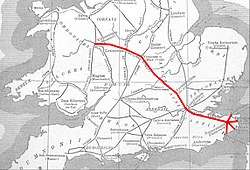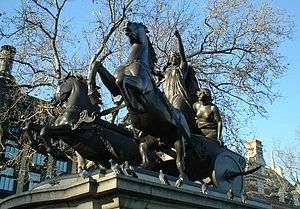Defeat of Boudica
The decisive battle ending the Boudican Revolt took place in Roman Britain in AD 60 or 61 between an alliance of British peoples led by Boudica and a Roman army led by Gaius Suetonius Paulinus. Although heavily outnumbered, the Romans decisively defeated the allied tribes, inflicting heavy losses on them. The battle marked the end of resistance to Roman rule in Britain in the southern half of the island, a period that lasted until 410 AD.[3]
| Climax of the Boudican Rebellion | |||||||
|---|---|---|---|---|---|---|---|
 Roman Britain with Watling Street highlighted in red. Watling Street was a strategic factor in the campaign and a suggested location for the final battle site. | |||||||
| |||||||
| Belligerents | |||||||
| Roman Empire | Iceni, Trinovantes, and other British peoples | ||||||
| Commanders and leaders | |||||||
| Gaius Suetonius Paulinus | Boudica | ||||||
| Strength | |||||||
| 10,000[1] | 230,000[2] | ||||||
| Casualties and losses | |||||||
| 400 dead[1] | 80,000 dead[1] | ||||||
Historians are dependent on Roman historians Tacitus and Dio Cassius for the only accounts of the battle.[4]
The location of the battlefield is not known; most historians place it between Londinium and Viroconium (Wroxeter in Shropshire), on the Roman Road now known as Watling Street. This name for the road originated in Anglo-Saxon times, thus the alternative modern name of the battle (Battle of Watling Street) is anachronistic and in the absence of evidence, speculative. However, the road that became known as Watling Street was clearly a significant strategic element in the campaign that led to the battle.
Background
In 43 AD Rome invaded southeastern Britain.[5] The conquest was gradual. While some kingdoms were defeated militarily and occupied, others remained nominally independent as allies of the Roman empire.[6]
One such people was the Iceni in what is now Norfolk. Their king, Prasutagus, thought he had secured his independence by leaving his lands jointly to his daughters and to the Roman emperor, Nero, in his will. However, when he died, in 61 or shortly before, his will was ignored. The Romans seized his lands and violently humiliated his family: his widow, Boudica, was flogged and their daughters raped.[7] Roman financiers called in their loans.[8]
When the Roman Governor of Britain, Gaius Suetonius Paulinus, was campaigning on the island of Mona (Anglesey, north Wales),[9] the Iceni allied with their neighbours the Trinovantes, whose former capital, Camulodunum (Colchester), was now a colony for Roman military veterans. To add insult to injury, the Romans had erected a huge temple to former emperor Claudius in the city, at local expense. The rebels descended on Camulodunum and destroyed it, killing all those who could not escape.[10]
Boudica and her army headed for Londinium (London). So did Suetonius and a small portion of his army but, arriving ahead of the rebels, he concluded he did not have the numbers to defend Londinium and ordered the city evacuated before it was attacked. Londinium, too, was burnt to the ground and the Roman historian Tacitus claims every inhabitant who could not get away was killed.[11]
While Boudica's army continued its assault in Verulamium (St. Albans), Suetonius regrouped his forces. According to Tacitus, he amassed a force including his own Legio XIV Gemina, parts of the XX Valeria Victrix and any available auxiliaries, a total of 10,000 men.[12] A third legion, II Augusta, near Exeter, failed to join him;[13] a fourth, IX Hispana, had been routed trying to relieve Camulodunum.[14]
Battle
Overwhelmingly outnumbered, Suetonius had chosen his battleground carefully. He selected a narrow gorge with a forest behind him, opening out into a wide plain. The gorge protected the Roman flanks from attack, while the forest would impede approach from the rear. This would have prevented Boudica from bringing considerable forces to bear on the Roman position, and the open plain in front made ambushes impossible. Suetonius placed his legionaries in close order, with auxilia infantry on the flanks and cavalry on the wings.[14]

As their armies deployed, the commanders would have sought to motivate their soldiers. Tacitus, who wrote of the battle more than 50 years later, claims to relate Boudica's speech to her followers:
"'But now,' she said, 'it is not as a woman descended from noble ancestry, but as one of the people that I am avenging lost freedom, my scourged body, the outraged chastity of my daughters. Roman lust has gone so far that not our very persons, nor even age or virginity, are left unpolluted. But heaven is on the side of a righteous vengeance; a legion which dared to fight has perished; the rest are hiding themselves in their camp, or are thinking anxiously of flight. They will not sustain even the din and the shout of so many thousands, much less our charge and our blows. If you weigh well the strength of the armies, and the causes of the war, you will see that in this battle you must conquer or die. This is a woman's resolve; as for men, they may live and be slaves.'"[15]
Although the Britons gathered in considerable force, they are said to have been poorly equipped, as the Iceni had been disarmed before the rebellion.[4] They placed their wagon train in a crescent at their end of the field, from which point their families could watch what they may have expected to be an overwhelming victory.[12] Two Germanic leaders, Boiorix of the Cimbri and Ariovistus of the Suebi, are reported to have done the same thing in their battles against Gaius Marius and Julius Caesar, respectively.[16]
Tacitus also wrote of Suetonius addressing his legionaries:
"Ignore the racket made by these savages. There are more women than men in their ranks. They are not soldiers—they're not even properly equipped. We've beaten them before and when they see our weapons and feel our spirit, they'll crack. Stick together. Throw the javelins, then push forward: knock them down with your shields and finish them off with your swords. Forget about plunder. Just win and you'll have everything."[17]
Although Tacitus, like many historians of his day, was given to invent stirring speeches for such occasions, Suetonius' speech here is unusually blunt and practical. Tacitus' father-in-law, the future governor Gnaeus Julius Agricola, was on Suetonius' staff at the time and may have reported it fairly accurately.[18]
Boudica led her army forward across the plain and into the narrowing field in a massive frontal attack. As they advanced, they were channeled into a tightly packed mass. Just before the Britons got into close contact with their enemies, the Romans threw their pila, a type of javelin, to cut down some of the charging Britons and to damage the shields of the others, forcing them to discard their shields and leave themselves exposed. When the Romans had exhausted their missiles, they rushed out and marched forward in a tightly packed wedge-like column. The Romans, with a clear advantage in armour, weapons and discipline, had a decisive advantage in the close-quarters fighting against the tightly packed Britons. The Roman cavalry, lances extended, then entered the battle.
As the Britons' losses increased they tried to retreat, but their flight was blocked by the ring of wagons and they were massacred. The Romans killed not only the warriors but also the women, children, and even pack animals. Tacitus relates a rumor that 80,000 Britons fell against the loss of only 400 Romans.[13] However, the figures quoted for the campaign in the ancient sources are regarded by modern historians as extravagant.[4][19]
Boudica is said by Tacitus to have poisoned herself;[13] Cassius Dio says she fell ill, died and was given a lavish burial.[20] Poenius Postumus, prefect of the 2nd Legion, which had failed to join the battle (thus robbing his men of a share of the glory), committed suicide by falling on his sword.[13]
Location
The site of the battle is not identified by either historian, although Tacitus gives a brief description.[13] A wide variety of sites, all consistent with an army attacking from the area of London toward the Roman forces concentrating from the direction of Cornwall and Wales, has been suggested. One legend places it at Battle Bridge Road in King's Cross, London, although from reading Tacitus it is unlikely Suetonius returned to the city.
Most historians favour potential location sites in The Midlands, probably along the Roman road between Londinium and Viroconium (Wroxeter), which became the Anglo-Saxon Watling Street and subsequently the A5.
Plausible suggestions include;
- Manduessedum (Mancetter), near Atherstone in Warwickshire,a site which was championed by Graham Webster and is still referenced as the most likely location in academia[21]
- A site close to High Cross in Leicestershire,[22]
- The area east of Rugby, Warwickshire, near the villages of Clifton-upon-Dunsmore and Hillmorton, south of Tripontium.[23]
- Cuttle Mill near Paulerspury, southeast of Lactodorum (Towcester) in Northamptonshire,[24][25][26]
- Arbury Banks, near Ashwell (Herts.)[27] was suggested in 2009 as a location.
- Church Stowe, Northamptonshire.[28]
- The Kennet valley, close to Silchester.[29][30]
- on Watling Street, just south of Dunstable, Bedfordshire.[31]
Aftermath
It is said that the emperor Nero was so shaken by these events that he considered withdrawing from Britain altogether,[32] but with the revolt brought to a decisive end, the occupation of Britain continued.
Fearing Suetonius' punitive policies would provoke further rebellion, Nero replaced him with the more conciliatory Publius Petronius Turpilianus.[33]
The defeat of Boudica ensured Roman rule in southern Britain; however, northern Britain remained volatile. In AD 69 Venutius, a Brigantes noble, would lead another less well documented revolt, initially as a tribal rivalry but soon becoming anti-Roman.[34]
References
- The Roman Empire: A Historical Encyclopedia [2 volumes].
- Cassius Dio, Roman History 62.8.2
- Webster, Graham (1978). Boudica the British revolt against Rome, AD 60. London: Routledge. ISBN 0415226066.
- Bulst, Christoph M. (October 1961). "The Revolt of Queen Boudicca in A.D. 60". Historia: Zeitschrift für Alte Geschichte. 10 (4): 496–509. JSTOR 4434717.
- Cassius Dio, Roman History 19-22
- Tacitus, Agricola 14
- Tacitus Annals 14.31
- Cassius Dio, Roman History 62.2
- Tacitus, Annals 14.29-39, Agricola 14-16; Cassius Dio, Roman History 62.1-12
- Tacitus, Annals 14.31-32
- Tacitus, Annals 14.33
- Tacitus, Annals 14.34
- Tacitus, Annals 14.37
- Tacitus, Annals 14.32
- Tacitus, Annals
- Florus, Epitome of Roman History 1.38; Julius Caesar, Commentarii de Bello Gallico 1.51
- Tacitus, Annals 14.36
- Cassius Dio (Roman History 9-11) gives Suetonius a quite different speech.
- Townend, G. B. (1964). "Some Rhetorical Battle-Pictures in Dio". Hermes. 92 (4): 479–80.
- Cassius Dio, Roman History 62.12.6
- Frere, Sheppard (1967). Britannia: a History of Roman Britain. London: Routledge & Kegan Paul. p. 91.
- Carroll, Kevin K. (1979). "The Date of Boudicca's Revolt". Britannia. 10: 197. doi:10.2307/526056. JSTOR 526056.
- "Boudica and Clifton... the final battle of the Celtic Revolt of AD60". Clifton-upon-Dunsmore Local History Group. Archived from the original on 4 February 2007. Retrieved 2 October 2019.
- British History Online, Paulerspury pp 111-117, last paragraph.
- Rogers, Byron (11 October 2003). "The original Iron Lady rides again". Daily Telegraph.
- Evans, Martin Marix. "Boudica's last battle". Osprey Publishing. Archived from the original on 27 September 2007.
- Appleby, Grahame A. (2009). "The Boudican Revolt: countdown to defeat". Hertfordshire Archaeology and History. 16: 57–65.
- Pegg, John (2010). "Landscape Analysis and Appraisal: Church Stowe, Northamptonshire". Cite journal requires
|journal=(help) - Steve, Kaye (September–October 2010). "Can Computerised Terrain Analysis Find Boudica's Last Battlefield?". British Archaeology (114). Archived from the original on 7 August 2016. Retrieved 5 July 2016.
- Kaye, Steve (February 2015). "Finding the site of Boudica's last battle: multi-attribute analysis of sites identified by template matching" (PDF). Banda Arc Geophysics.
- Horne, Barry (2014). "Did Boudica and Paulinus meet south of Dunstable". South Midlands Archaeology. 44: 89–93.
- Suetonius, Nero 18, 39-40
- Tacitus, Annals 38-39
- Tacitus, Histories, 3.45